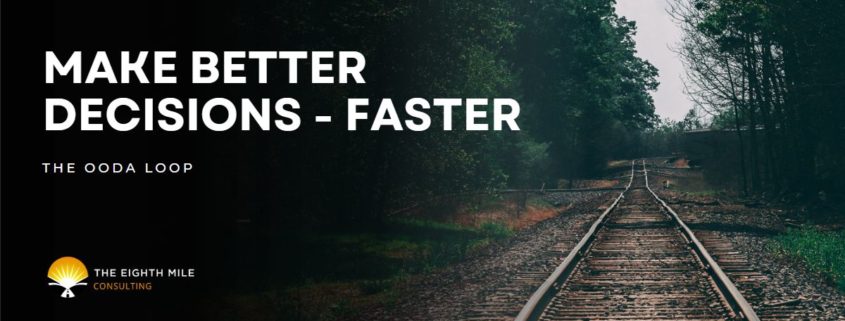The OODA Loop is an acronym for Observe, Orient, Decide, and Act. It’s also called the Boyd Cycle, named for military strategist U.S. Air Force Colonel John Boyd, who developed this decision-making process. In a nutshell, it is a cybernetic theory of strategic planning in business that can apply to any situation or process. By using these four distinct steps, individuals or organizations learn how to make better decisions faster.
OODA Loop-Related Terminology and Why it’s Important to Strategic Planning in Business
Before we get into the finer points of the OODA loop, how to make decisions faster, and learning to be strategic about planning for your business, there are a few terms you should be familiar with first.
-
Maneuver warfare is a military strategy of outwitting enemy forces in battle, rendering them vulnerable to attack. Maneuver warfare draws heavily on the principle of acting fast with available resources. It’s the concept from which the OODA loop originated.
-
Mental models are a way to evaluate your thoughts, which helps you understand how to make decisions faster. They help reveal and overcome any pre-existing assumptions that could prevent you from being strategic in planning for your business.
-
Situational awareness describes an individual’s knowledge of a situation and how much of that knowledge they receive from sources outside their direct influence. Drawing information from multiple sources is crucial for making better decisions faster rather than relying solely on your own perception.
-
Reaction time is the time it takes you to react to a stimulus. Tracking reaction time as tasks get added to a process can help planners optimize strategies.
The 4 Steps of OODA
Like other problem-solving methods, the OODA loop is an interactive, iterative process that involves repeating the cycle, observing and measuring results, reviewing and revising the initial decision, and advancing to the next step. While the process is not always simple or linear, the four phases are relatively easy to understand.
-
Observe: The first step in the OODA Loop is to observe what’s going on in your environment. This step includes taking in as much information as possible from the surrounding environment. This includes gathering intelligence and looking for patterns, signals, and cues that may indicate either a threat or opportunity in your industry.
-
Orient: The second step of the process is to orient yourself in response to what you’ve observed based on your company’s goals and values. This is an evaluative period of the loop, in which you decide whether your company should respond to a given circumstance and what that response might look like.
-
Decide: After you have developed a number of potential responses to the situation, the third step is to choose a course of action. Perhaps you choose to engage the “enemy” directly, or perhaps you decide to pursue an alternate route to the same destination. Either way, you must be prepared to fully commit to this single course of action.
-
Act: Finally, after gathering data and determining the best course of action, the fourth and final phase is to put your chosen plan into effect.
But that’s not the end of the process — it’s called a “loop” for a reason. After you’ve acted, you must return to the beginning to observe how your action has affected the environment and how that will affect your next move.
Only 32% of data available to enterprises is put to work. The remaining 68% is unleveraged.
Use the OODA Loop to Make Faster Decisions in Strategic Business Planning
Military strategies are designed to be effective under chaotic, conflicting scenarios and allow for versatile reactions. In the business world, agility is essential for any company to succeed. Organizations that can adapt or react the fastest are the ones that win. Thus, the OODA loop has seamlessly translated into strategic planning in business.
So how might this look in your business?
Let’s say a competitor has a wildly successful online presence that you’d like to emulate or overtake. You can use the OODA Loop to learn how to make decisions faster and be strategic about planning for your business.
- Observe the competitor’s actions online. What do they do? How do they interact with customers? What platforms and strategies are they using?
- Orient your company’s online marketing strategy while staying true to your unique business persona and values.
- Decide on the online marketing strategy that’s most appropriate and feasible for your company.
- Act by putting your strategy into effect.
- Start the cycle again. Observe the response to your new approach and orient/decide/act again. Repeat until you achieve your desired outcome.
Online Leadership Guidance from Eighth Mile
Using the OODA Loop in your business takes more than following a simple series of steps to make decisions faster. It requires self-awareness, honesty, courage, and plenty of practice. The Eighth Mile helps business leaders develop highly effective leadership skills that build dedicated, high-performance teams. Whether you’re an entry-level to mid-career employee, a new manager, or an entrepreneur, our eight-week online leadership course will help you make decisions that make a difference. Get in touch to learn more.




Trackbacks & Pingbacks
[…] of your leadership environment. A wise leader understands and carries the burdens of both planning and execution. Find the right balance between responding to events as a leader and taking time to think through […]
Leave a Reply
Want to join the discussion?Feel free to contribute!